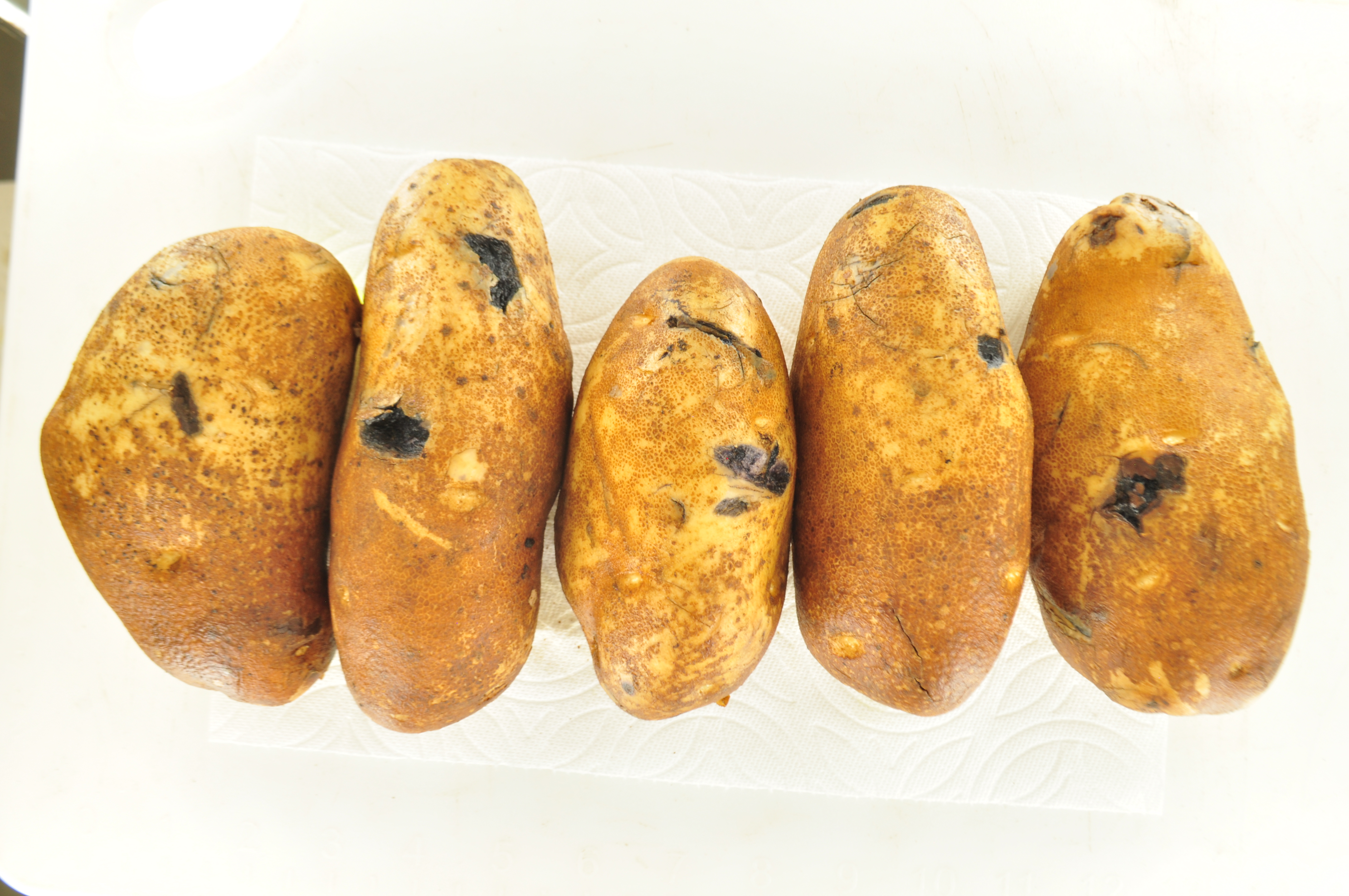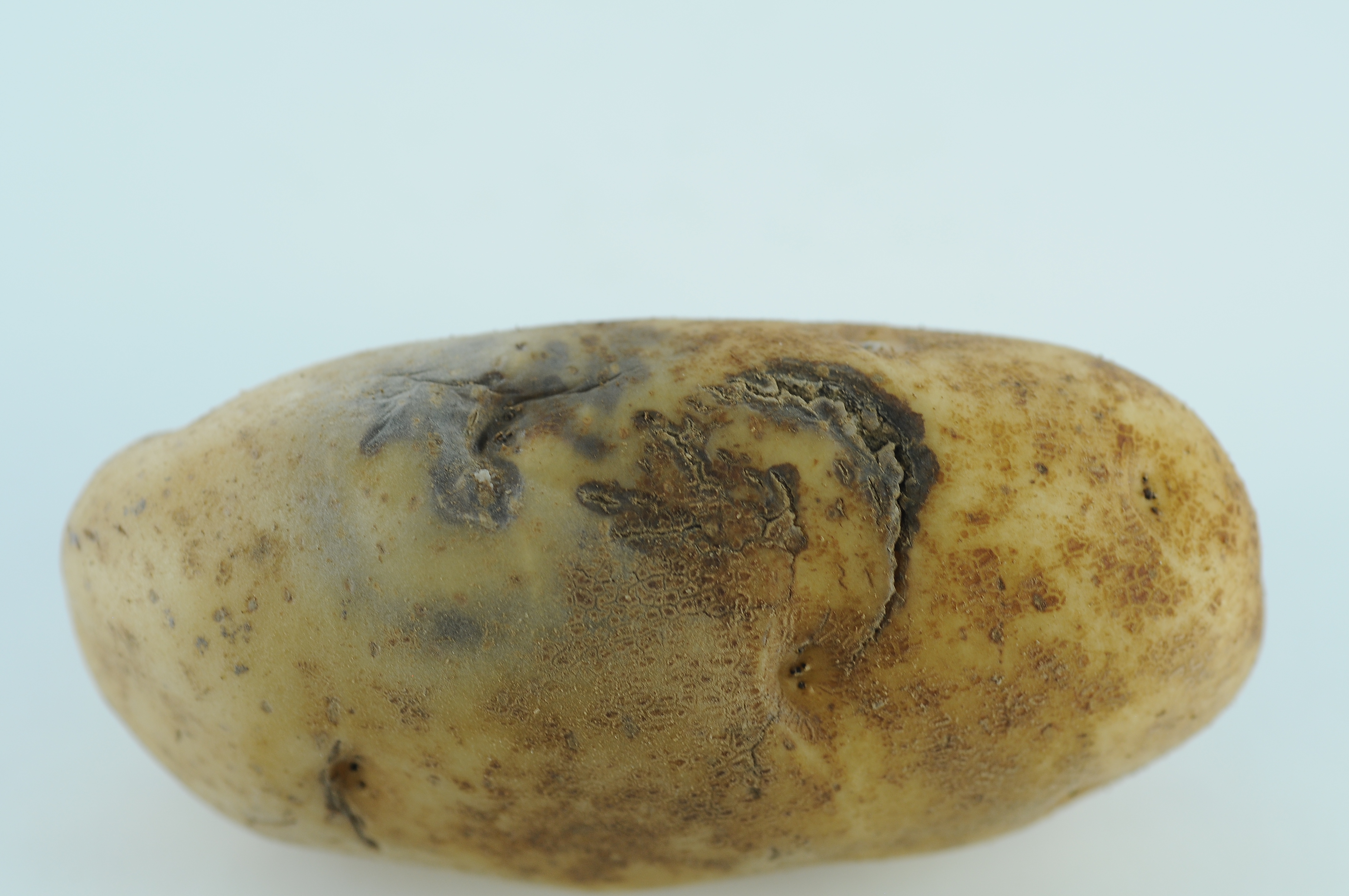Major injuries that happen to potatoes at harvest include cuts, shatter bruises and blackspot bruises. Cuts are usually obvious to the eye, but blackspot bruises are mostly undetectable unless the tubers are peeled. Some shatter bruises are easy to see, while others are not as obvious.
The consequences of shatter bruise on overall potato quality are numerous. The first major detriment to quality is that a shatter bruise is an entry point for pathogen invasion, especially the pathogens that cause Fusarium dry rot and  Pythium leak, which need a wound to infect. Both of these are significant diseases to manage in storage. Secondly, a shatter bruise is also an exit point for water. There is a tremendous loss of water through a shatter bruise until wound healing is complete. It can take days—sometimes weeks—to heal a severe shatter bruise, and during that time additional shrinkage occurs. This extra water loss can make the potato more prone to pressure bruise. Lastly, a major quality detriment of shatter bruise is the defect itself that degrades visual appearance that can provide a reason for rejection or downgrade of the crop.
Pythium leak, which need a wound to infect. Both of these are significant diseases to manage in storage. Secondly, a shatter bruise is also an exit point for water. There is a tremendous loss of water through a shatter bruise until wound healing is complete. It can take days—sometimes weeks—to heal a severe shatter bruise, and during that time additional shrinkage occurs. This extra water loss can make the potato more prone to pressure bruise. Lastly, a major quality detriment of shatter bruise is the defect itself that degrades visual appearance that can provide a reason for rejection or downgrade of the crop.
 Quantifying shatter bruise during harvest will provide time to make modifications to harvest equipment and handling conditions, and to identify lots or fields that have a greater degree of shatter bruising. A high level of shatter bruise will demand more intensive storage management to promote wound healing, minimize disease development, and avoid higher weight loss and pressure bruise potential. Setting up a detection program at harvest can help in quickly identifying the level of shatter bruise of the incoming crop.
Quantifying shatter bruise during harvest will provide time to make modifications to harvest equipment and handling conditions, and to identify lots or fields that have a greater degree of shatter bruising. A high level of shatter bruise will demand more intensive storage management to promote wound healing, minimize disease development, and avoid higher weight loss and pressure bruise potential. Setting up a detection program at harvest can help in quickly identifying the level of shatter bruise of the incoming crop.
A relatively easy way to detect shatter bruise is using an iodine solution. Iodine interacts with starch to form a blue color. Any break in the skin of the potato, such as a shatter bruise, will expose the starch in the tissue to the iodine solution, which will turn a blue/black color. This coloration makes it much easier to determine the number and severity of the shatter bruises. Commercial iodine solutions (typically a 5 to 10 percent iodine concentration) can be found at any farm/ranch store in the livestock department. These solutions are considered safe and are generally used to prevent infection of wounds on livestock.
The procedure is simple, but takes some setup to get ready. Sample 15 to 30 potatoes from each location of interest, place in a mesh bag, and tag. Potatoes should be washed before soaking in the diluted iodine solution. Washing will help keep the iodine solution clean and allow the shatter bruises to color more readily. Set up two garbage cans—one to wash and rinse mesh-bagged potatoes, and the second for the diluted iodine solution. The iodine solution is mixed with water to produce various concentrations; the ratio will determine how much time tubers need to soak to discolor shatter bruises. A 1:1 ratio of iodine solution to water) may take 30 minutes to color, whereas a more diluted solution (1:9 ratio) may take up to an hour. Soak the sample bags in the diluted iodine solution for the appropriate amount of time.
After soaking, rinse potatoes with water, then evaluate and/or count the number of shatter bruises per potato or sample. Potatoes do not need to be peeled to see the shatter bruise colored blue. It is recommended to use gloves and dispose of the solution as you would other pesticides. The iodine solution can be reused if kept clean and covered. Tubers that have been soaked in the solution should be discarded.
An important key to maintaining potato quality in storage is minimizing shatter bruising at harvest. There are many factors involved in shatter bruise development: cultivar susceptibility, low pulp temperatures, high potato turgidity or hydration, and the impact force. Having knowledge of the crops’ shatter bruise level can give you time to alter conditions or equipment to reduce bruising and to manage storage conditions to mitigate quality issues.
Nora Olsen, Andrew Hollhingshead and Mike Thornton are all potato specialists with the University of Idaho Extension system. They can be contacted, respectively, at norao@uidaho.edu, akhollingshead@uidaho.edu, and miket@uidaho.edu.